Laminate Flooring Costs Explained
Last updated 16th September, 2025
Looking to find out how much it costs to lay laminate flooring in 2025?
In this guide, we cover everything there is to know about the costs of laminate flooring fitting.
This includes average laminate flooring prices per m², what you should budget for laminate flooring labour costs in the UK, additional costs you might need to consider, and much more.
Let's get straight to it!
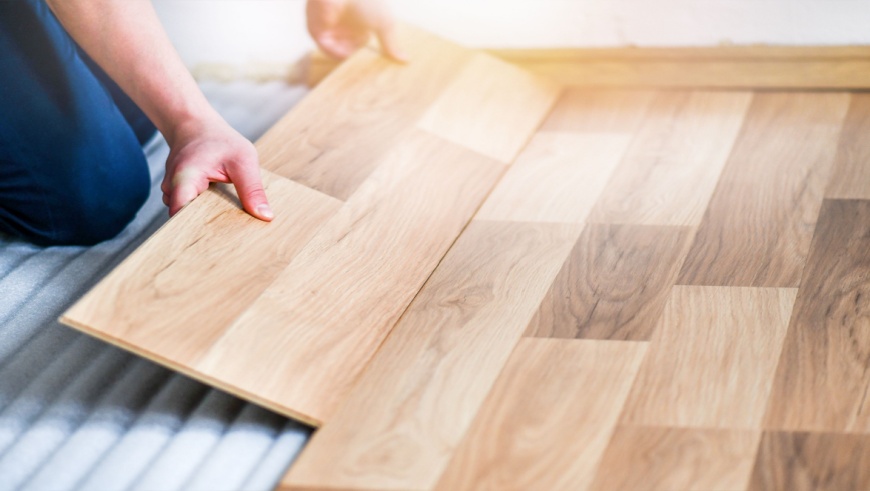
Table of Contents
- How much to lay laminate flooring?
- Laminate flooring labour costs & time frames
- What does laying laminate flooring entail?
- Laminate flooring removal cost
- Laminate flooring pros and cons
- Additional laminate flooring costs
- Cost of laminate flooring on stairs
- Laminate flooring textures and finishes
- Do I need underlay for my laminate flooring?
- Can I lay laminate flooring myself?
- Laminate flooring edging options
- AC rating
- How do I know if I’m buying good quality laminate flooring?
- Laminate flooring maintenance costs
- How to clean laminate flooring
- Laminate flooring alternatives
- FAQs
- How to find and hire a laminate floor installer
- Sources
How Much to Lay Laminate Flooring?
The average laminate flooring installation cost is between £15 and £27 per square metre in the UK. This estimate includes average laminate material and fitting costs.
This would mean that typical laminate flooring fitting costs are around £240 to £432 for an average-sized room (about 16m²). Prices would be between £150 and £270 for a smaller room (about 10m²) and around £375 to £675 for a larger space (about 25m²).
The cost to fit laminate flooring varies depending on the type of material you want to use. The table below highlights how this choice impacts the typical price per square metre for laminate flooring fitting.
| Laminate Material | Installation Cost per m² |
|---|---|
| Walnut laminate | £17 – £22 |
| Oak laminate | £20 – £22 |
| Maple laminate | £21 – £23 |
| Hickory laminate | £26 – £28 |
| Elm laminate | £30 – £32 |
Let's break this down a little:
The cost of laminate flooring is around £5 to £15 per square metre. Laminate flooring prices will vary depending on the type of laminate material you want to install — with hickory and elm laminate being the more expensive options.
The average laminate flooring labour cost in the UK is around £150 per day. Most experienced laminate flooring installers can complete an average-sized job in about a day. Excluding materials, this puts the cost to fit laminate flooring at between £10 to £12 per square metre.
But what else impacts laminate flooring installation costs?
One significant factor that impacts the prices you're quoted is the shape of the room that you're looking to install laminate flooring in. This is because rooms that aren't just square or rectangular will require the laminate installer to spend more time on the project and increase the amount of material waste.
You should also expect laminate flooring costs to be higher if existing flooring has to be removed, or if there are problems with the subfloor that have to be dealt with.
Laminate Flooring Installation Costs
Below are some estimated costs for the supply and installation of laminate flooring, based on room sizes that range from 10m² to 25m². The costs below include removing the old carpet, fitting underlay and installing the laminate flooring:
| Laminate Material | Average Cost |
|---|---|
| Walnut laminate | £200 – £550 |
| Oak laminate | £230 – £625 |
| Maple laminate | £240 – £650 |
| Hickory laminate | £290 – £775 |
| Elm laminate | £330 – £875 |
How Much Is Laminate Flooring?
If you’re going to install the laminate flooring yourself, you don’t need to worry about the installation price, only the supply costs.
Here is a breakdown of the different supply costs.
| Material | Laminate Flooring Cost per m² |
|---|---|
| Walnut laminate | £7 – £16 |
| Oak laminate | £7 – £18 |
| Maple laminate | £9 – £14 |
| Hickory laminate | £16 – £24 |
| Elm laminate | £20 – £26 |
Laminate Flooring Cost Breakdown Calculator
Individual costs to install laminate flooring for the area of one average-sized room (roughly 16m²).
Total Cost: £450
Materials
£225
Tradesmen
£180
Waste Removal
£45
Laminate Flooring Labour Costs & Time Frames
Even if you are sure how to fit laminate flooring on your own, before making a final decision just get some quotes from professional fitters then weigh up all the pros and cons of both options. You may find that the costs are more reasonable than you thought and just go ahead and get a professional in to do the job anyway.
A fitter's daily rate is normally around £150 per day, and they can complete an average-sized room within that time. Some floor fitting specialists tend to charge per square metre, with the average installation rate of £10 to £12 per square metre.
Smaller rooms may cost even less and take less time. Small rooms tend only to take a day to complete, while larger rooms can take up to 7 days — depending on the material used and whether or not the fitters need to remove the existing flooring.
What Does Laying Laminate Flooring Entail?
There are several steps involved in the installation of laminate flooring.
Let's take a look at these now below.
- Measuring The Room - Exact measurements are taken, with diagrams if the room has irregular shapes like chimney breasts or alcoves, to determine the correct flooring size.
- Removing Skirting Boards - Once the room has been cleared of any furniture, skirting boards are removed if necessary, before proceeding to preparing the floor area.
- Preparing The Sub-Floor - It must be smooth and dry, and screeding (concreting and smoothing) or a waterproof membrane may be applied and the floor cleared of any debris.
- Fitting The Underlay - Underlay is cut to size with a 16mm gap around pipes, and taped at the seams. The material used depends on options such as waterproofing for kitchens or bathrooms.
- Installing The Laminate - Starting in a corner, boards are placed using the click system, along with spacers left around any edges to allow expansion and to help prevent damage.
- Finishing Touches - After installation, skirting boards and trims are replaced or installed, and gaps covered. Final checks ensure even spacing and a neat finish.
Laminate Flooring Removal Cost
If you want new flooring, you will need to remove your existing laminate flooring to do so.
Laminate flooring removal costs start from just £3 per square metre. Many companies will include this within their quoted prices. Exact costs vary depending on the size of your room and how long the tradesperson expects it will take them to remove the existing laminate flooring.
Some contractors charge per hour while others set their prices based on measurements. You should expect a trained carpenter to charge about £13 per hour to complete this type of job. It might take around a day to finish, but this will depend on the size of the room.
To remove the floor, a skill saw is typically used to cut the middle of each laminate plank to break the adhesive then a chisel and mallet can be used to tap underneath the plank’s edges with a chisel and a mallet to remove the planks.
If this doesn’t work, a heat gun can be used to melt the adhesive, or if you are doing it yourself, you could rent a motorised floor stripper with claws attached to remove the planks. While this is one of the easiest ways to remove laminate flooring, it is expensive, costing around £80 per day, and you must also be extremely careful.
Laminate Flooring Pros and Cons
Laminate flooring has probably been the most popular flooring in the UK for many years and even today remains a very popular choice. Before you decide to have laminate flooring installed in your home, you should weigh up the pros and cons to see if this is the right choice for you.
Pros
✔ Easy to maintain.
✔ Expensive aesthetic.
✔ Variety of applications.
✔ Underfloor heating can be added.
✔ Underlay can be built-in.
Cons
✖ Can be difficult to install.
✖ May require specialist cleaning.
✖ Not entirely resistant to moisture.
✖ Requires a full replacement if damaged.
✖ Can be slippery.
Additional Laminate Flooring Costs
To finish off your laminate flooring, there are some additional extras to consider such as the following.
Trims and Moulding
Mouldings are used to cover the transition from one service to another, which also help add an aesthetic element to the finishing of one room and the start of another. In regards to installing laminate flooring, moulding options include:
- Quarter-Round Moulding - cost around £4 to £15 for a 94-inch length
- Threshold Moulding - typically priced at around £22 to £25 for a 78-inch length
- T-Moulding - for a clean transition costing around £22 to £28 per 78-inch length
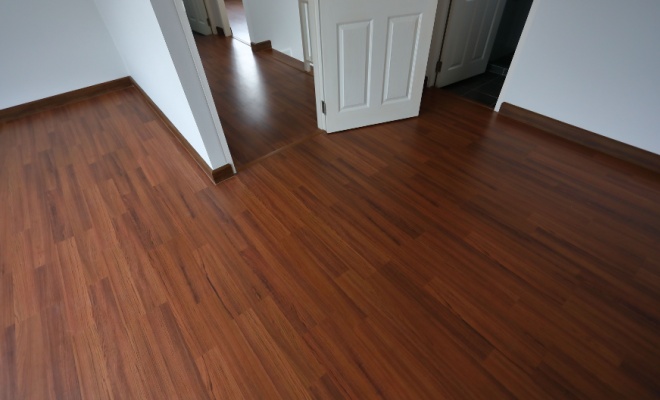
Skirting
Replacing skirting boards costs are usually between £203 and £342, depending on the size and complexity of the room.
Waste Removal
You may need to consider the skip hire cost when removing old flooring, which is typically between £180 to £320. Alternatively, you may be able to take your waste to a local recycling centre, if they accept the materials.
Other Types of Flooring
Although laminate is ideal for certain rooms such as the kitchen or bathroom, you may wish to consider other types of flooring elsewhere around the home. Among these, may include wooden flooring (anywhere from £350 to £2,700) or carpet fitting (between £330 and £600 for a mid-range carpet in average-size room).
Cost of Laminate Flooring on Stairs
If you want to have laminate flooring installed on your stairs, you should expect to pay around £35 to £96 per step, although this will depend on the material you choose, as well as how long the installation will take.
Installing laminate flooring on your stairs can be a difficult task, as it involves removing the original overhang to make room for a customised overhang. Professionals will also need to prepare three pieces, including the tread for the top of the step, riser pieces for the front of the step and stair nosing for the overhang.
There are two main types of stair nosing, including flush mount which adds a rounding effect to your stair floor. This is ideal for a home that receives a significant amount of foot traffic and usually costs around £31 to £59 for a 78-inch length.
Another type is step nose or overlapping step nose which provides horizontal and protruding qualities that offer a non-slip application. This style is typically priced anywhere between £14 and £74 for a 78-inch length.
Laminate Flooring Textures and Finishes
There are a variety of different textures and finishes to choose from when deciding on laminate flooring. Here is a breakdown of different types of textures and finishes, their costs per square metre, and their pros and cons.
Textures
| Texture | Cost | Pros | Cons |
|---|---|---|---|
| Hand-scraped | £11 – £17 | - Hides flaws easily - Good for a high foot traffic - Versatile material |
- It cannot be re-sanded - Hard to install - Expensive |
| Embossed in Register | £17 – £30 | - Made from real wood planks - Wide range of styles - Long-lasting warranty |
- Can be costly for large rooms - Thin flooring is less sustainable - Tricky production and installation |
| Satin | £10 – £32 | - Low-maintenance - Reflects light well - Smooth texture |
- Not suitable for wire brushed floor - Does not hide imperfections well - Can be slippery |
| Brushed/oiled | £42 – £52 | - Authentic aesthetic - Scratches are hidden - Less slippy |
- Difficult to maintain - Can look unnatural - Less durable when sanded |
Finishes
| Type of finish | Cost per square metre |
|---|---|
| Lacquered | £20 – £68 |
| Brushed and lacquered | £31 – £51 |
| Brushed and oiled | £30 – £54 |
| Hand-scraped | £39 – £44 |
Do I Need Underlay for My Laminate Flooring?
Yes, laminate flooring underlay is necessary when fitting your laminate, as it is a floating floor, therefore it requires underlay for stability and insulation.
Underlay also works to reduce noise around the home. While the cost of soundproofing floors varies depending on the type of flooring you have, it should always be used in conjunction with laminate flooring for the best results.
Underlayment is a thin cushioning layer which lies under your flooring and can be made up of several materials such as foam, rubber, felt, plastic and more. This not only provides support but also offers you comfort and can reduce wear on your flooring.
Laminate flooring underlay costs around £2 to £4 per square metre for a concrete subfloor and between £2 and £5 per square metre for a wooden subfloor. Some types of flooring have pre-attached underlay, which may be beneficial — however, you can always purchase the type of underlayment you want separately.
Adding underlay to your laminate flooring can help improve insulation and reduce heat loss, enhancing your home's energy efficiency and creating a more comfortable atmosphere.
Can I Lay Laminate Flooring Myself?
When laying a new floor, some decide to do so as a DIY project, but most will hire a professional. The advantages of DIY laminate floor fitting are the significantly lower costs, which is perfect for anyone sticking to a low budget.
Any DIY flooring project is going to be much cheaper than getting a professional to do it, but this is only because we don't charge for our own time when doing DIY projects.
The disadvantages of DIY floor installation include the additional time it will take, especially if you're working on the project only in your spare time. Plus, if you don't already have all the proper tools, it may be quite costly to buy or hire them.
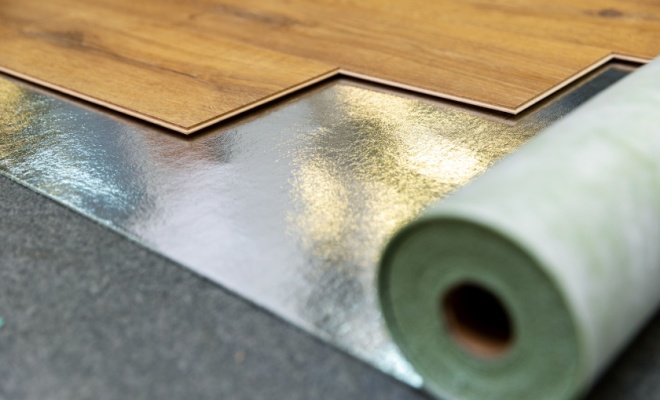
The main drawback of DIY flooring is that it is a job which requires meticulous exactitude. If you don't have the necessary patience, you won't achieve a good result. This may end up costing you even more if you have to hire someone to correct mistakes.
If you are not good at DIY projects and don't have any real experience with flooring, then you should hire a professional fitter to achieve a high-quality finish, plus get a guarantee against any problems that may occur after the installation.
Note that if you buy laminate flooring and make a mess of the job, it will cost you even more in the long run than getting an experienced fitter to do it.
If you feel confident laying your laminate flooring yourself, you need to make sure you have the following tools and materials to complete the job:
Tools & Materials Required
If you feel confident laying your laminate flooring yourself, you need to make sure you have the following tools and materials to complete the job:
Tools Required
- Punches & nail setters
- Panel saw
- Clamps
- Circular saws
- Knife
- Tape measure
- Claw hammer
- Carpenter squares
- Levels
Materials Required
- Underlayment
- Floor installation kit
- Caulk and sealant
- Laminate sealer
- Duct tape
- Floor patch
- Finishing nails
- Patch and repair substance
- Laminate trim
- Thresholds
- Finishing nails
Laminate Flooring Edging Options
To finish off your flooring, you should consider the different types of edging and their costs.
| Type of Edging | Cost per m² | Application |
|---|---|---|
| Bevelled | £13 – £38 | A V-groove style offering an authentic feel. |
| Micro-bevelled | £17 – £38 | Not as angled as the bevel-style. |
| Square | £14 – £21 | Straight edge planks cut to a 45-degree angle. |
AC Rating
AC Rating is a measurement used for laminate flooring which determines the right application, with some types of laminate being able to handle more foot traffic than others.
To establish the rating, all laminate flooring is tested for durability, abrasion, and staining. To achieve the measurement, the flooring must pass all tests, but if they do not, the product will be disqualified from sale.
Here is a breakdown of the different AC Ratings, along with the various applications and costs per square metre:
| Rating | Cost | Application |
|---|---|---|
| AC1 | £5 – £13 | Typically used in bedrooms or wardrobes. |
| AC2 | £5 – £32 | Suitable for dining rooms or living rooms. |
| AC3 | £5 – £23 | Can be used in all rooms in the home with high foot traffic. |
| AC4 | £8 – £27 | Suitable for all residential space as well as commercial premises with low traffic. |
| AC5 | £15 – £18 | Built with four protective layers and typically used for large commercial spaces. |
How Do I Know If I’m Buying Good Quality Laminate Flooring?
The main misconception that many people have when buying laminate flooring is that thickness is the most important element. While thickness can make flooring much more realistic, it is not the be-all and end-all. Instead, you should consider the density of the flooring.
Laminate flooring is usually made up of either medium-density fibreboard or high-density fibreboard (HDF) which are made of broken-down softwood fibres that are mixed with a resin binder and wax and heat-pressured into the laminate panels.
The difference between MDF and HDF is that the latter is much more durable and sustainable, making your flooring much better.
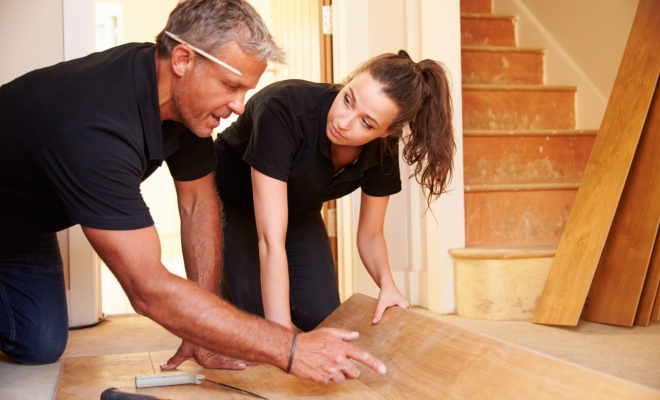
The AC rating is also important. Usually, the higher the measurement, the higher the quality. So, even if AC5 laminate is designed for commercial spaces, it doesn't mean you can’t use it in your home. However, it will be more expensive.
Laminate Flooring Maintenance Costs
The good thing about laminate flooring is that it is relatively low-maintenance; therefore, it does not require an extensive routine to keep it looking good. However, there are some things you should avoid doing to keep your floor in tip-top shape.
This includes avoiding harsh chemicals and instead just using water to keep it clean. You could also consider getting a doormat for each entrance to avoid mud being trailed in, as this will also reduce maintenance time.
Some floor fitters advise you to install pads underneath your tables and chairs to avoid any dents or scratches on the floor. These can cost anywhere between £0.50 and £10 per pack.
How To Clean Laminate Flooring
When cleaning your laminate floor, you should avoid using a wet mop or a steam cleaner as this can damage your floor. You should also refrain from using soap or any liquid cleaning product as this will wear down the floor. Instead, you should just use a damp cloth straight away on any spills to avoid any staining.
If any tougher liquids, such as lipstick, paint or ink come in contact with your laminate flooring, then you should use acetone nail polish remover on a clean cloth then wipe away with a damp cloth.
For regular cleaning, you should just use a brush or a vacuum with a hard floor attachment to remove any dust or dirt. This will prevent your floor from losing its finish, as some attachments can cause laminate material to look dull. If you do not have an attachment, you can always purchase the right tools for your hoover, which typically costs around £8 to £15.
You may also want to factor in the cost of hiring a professional cleaner to help maintain your new flooring if you don't have the time yourself or you don't feel confident about it.
Laminate Flooring Alternatives
There are various other types of flooring you could consider besides laminate flooring.
One of the most popular alternatives is hardwood flooring, which, unlike most laminate applications, is made up of real wood. However, wooden flooring costs make it a more expensive option at around £50 to £100 per square metre. However, it is one of the most durable and aesthetically pleasing flooring products.
A similar style of flooring to hardwood is engineered wood, which costs around £20 to £50 per square metre. This type of flooring is made to look like real wood and is arguably more realistic-looking than laminate. It is also less prone to expansion as it is extremely moisture-resistant, although, despite this, laminate is still the more durable of the two.
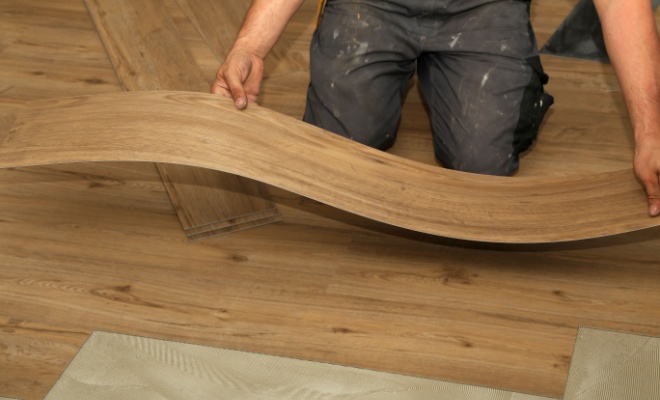
Luxury vinyl tile is another common application in the home, as it is much more affordable than laminate at around £5 to £26 per square metre, although the installing vinyl flooring can be much higher in some cases. Similar to laminate flooring, it recreates the wood aesthetic using a photo-realistic print film layer.
This is protected with polyurethane, which prevents scratches. Another advantage of LVT is that it offers less noise pollution than other types of flooring, although it is not as durable as laminate.
Finally, carpet may not be as popular as it once was, but it may still be the right option for your home. With carpet fitting costs ranging between £70 and £1,000 based on the size of the room and whether underlay is required, it could still work out to be a cheaper option than laminate.
FAQs
How to Find and Hire a Laminate Flooring Installer
When you're searching for a tradesperson to install laminate flooring, it's a good idea to ask them for examples of previous work they've done and references from other people that they've worked for. This will give you a better picture of what the tradesperson is capable of and how professional they are.
It's also always a good idea to find a laminate flooring installer who has liability insurance. If anything goes wrong, this will mean that any damage caused by the tradesperson would be covered — and you wouldn't end up out of pocket.
Want to find a laminate floor installer near you?
Get 3 FREE quotes from local tradespeople.
Sources
https://www.hunker.com/13402373/how-to-lay-laminate-flooring-over-an-uneven-floor/
https://home.howstuffworks.com/home-improvement/home-diy/flooring/how-to-remove-laminate-flooring.htm
https://www.tilesuperstore.co.uk/help-and-advice/product-guides/laminate-flooring/laminate-buyers-guide/
https://www.vileda.co.uk/cleanspiration/cleaning-tips/how-to-clean-laminates-floor










